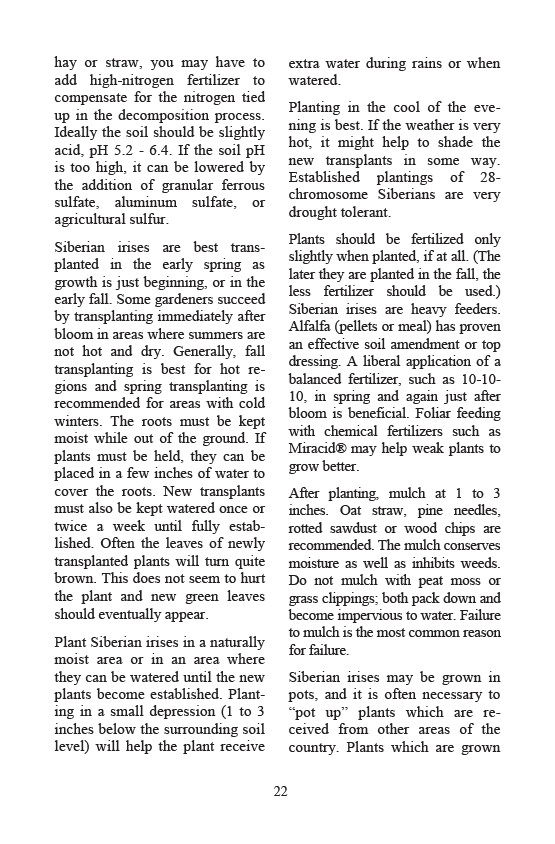
22
hay or straw, you may have to
add high-nitrogen fertilizer to
compensate for the nitrogen tied
up in the decomposition process.
Ideally the soil should be slightly
acid, pH 5.2 - 6.4. If the soil pH
is too high, it can be lowered by
the addition of granular ferrous
sulfate, aluminum sulfate, or
agricultural sulfur.
Siberian irises are best trans-planted
in the early spring as
growth is just beginning, or in the
early fall. Some gardeners succeed
by transplanting immediately after
bloom in areas where summers are
not hot and dry. Generally, fall
transplanting is best for hot re-gions
and spring transplanting is
recommended for areas with cold
winters. The roots must be kept
moist while out of the ground. If
plants must be held, they can be
placed in a few inches of water to
cover the roots. New transplants
must also be kept watered once or
twice a week until fully estab-lished.
Often the leaves of newly
transplanted plants will turn quite
brown. This does not seem to hurt
the plant and new green leaves
should eventually appear.
Plant Siberian irises in a naturally
moist area or in an area where
they can be watered until the new
plants become established. Plant-ing
in a small depression (1 to 3
inches below the surrounding soil
level) will help the plant receive
extra water during rains or when
watered.
Planting in the cool of the eve-ning
is best. If the weather is very
hot, it might help to shade the
new transplants in some way.
Established plantings of 28-
chromosome Siberians are very
drought tolerant.
Plants should be fertilized only
slightly when planted, if at all. (The
later they are planted in the fall, the
less fertilizer should be used.)
Siberian irises are heavy feeders.
Alfalfa (pellets or meal) has proven
an effective soil amendment or top
dressing. A liberal application of a
balanced fertilizer, such as 10-10-
10, in spring and again just after
bloom is beneficial. Foliar feeding
with chemical fertilizers such as
Miracid® may help weak plants to
grow better.
After planting, mulch at 1 to 3
inches. Oat straw, pine needles,
rotted sawdust or wood chips are
recommended. The mulch conserves
moisture as well as inhibits weeds.
Do not mulch with peat moss or
grass clippings; both pack down and
become impervious to water. Failure
to mulch is the most common reason
for failure.
Siberian irises may be grown in
pots, and it is often necessary to
“pot up” plants which are re-ceived
from other areas of the
country. Plants which are grown